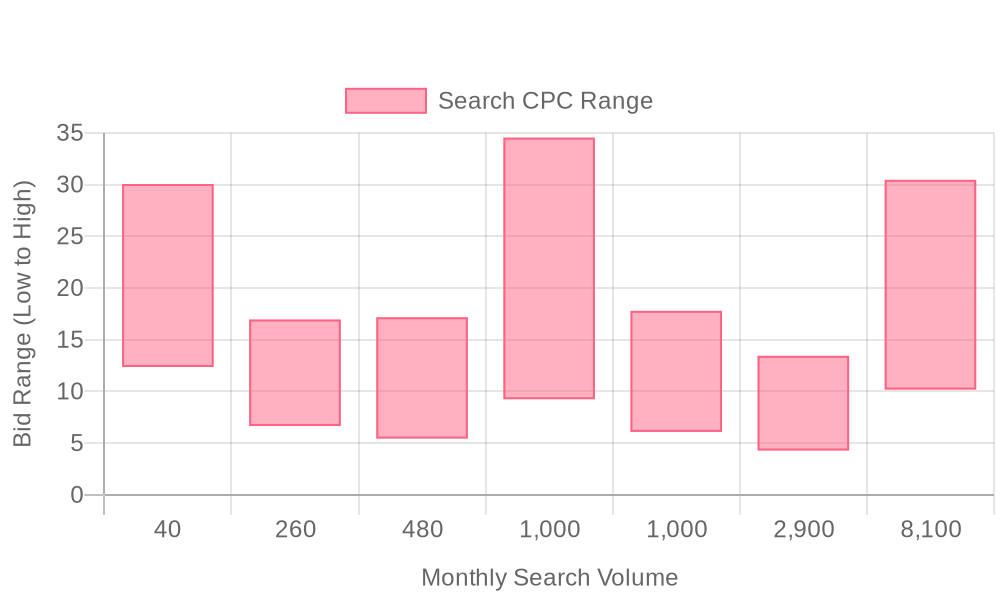
Supercharge your lead generation with a FREE Google Ads audit - no strings attached! See how you can generate more and higher quality leads
Get My Free Google Ads AuditFree consultation

No commitment
Supercharge your lead generation with a FREE LinkedIn Ads audit - no strings attached! See how you can generate more and higher quality leads
Get My Free Google Ads AuditFree consultation

No commitment
Supercharge your lead generation with a FREE Meta Ads audit - no strings attached! See how you can generate more and higher quality leads
Get My Free Google Ads AuditGet My Free LinkedIn Ads AuditGet My Free Meta Ads AuditFree consultation

No commitment
Supercharge your lead generation with a FREE Google Ads audit - no strings attached! See how you can generate more and higher quality leads
Get My Free Google Ads AuditFree consultation

No commitment
In today's multi-dimensional marketing landscape, integrating digital and traditional channels is crucial for maximizing reach and enhancing customer acquisition strategies. Google Ads for Direct Mail Advertising represents a powerful fusion, offering a strategic synergy that capitalizes on the strengths of both online and offline tactics. By effectively capturing high-intent prospects while they're actively searching, this approach bridges the gap between awareness and conversion in your marketing funnel. This outline provides a comprehensive guide to leveraging Google Ads alongside direct mail campaigns for optimal results.

Integrating Google Ads with direct mail campaigns empowers B2B marketing teams to reach decision-makers with precision and consistency. By coordinating digital intent signals with physical mail outreach, marketers capture attention in both inboxes and mailboxes, increasing conversion rates and overall ROI.
A data-driven approach to Google Ads for direct mail advertising ensures that ad spend aligns with signals of real purchase intent. Rather than casting a wide net, marketers can focus budgets on audiences that demonstrate in-market behaviors, improving efficiency and reducing wasted impressions. Combining these digital insights with targeted direct mail allows for highly personalized outreach, directly addressing the needs and interests of key accounts.
Techniques for precise keyword and audience targeting are foundational. With advanced visitor identification, marketers move beyond anonymous clicks to pinpoint which companies are engaging with online content. These insights enrich CRM records, ensuring high-intent prospects are tracked and segmented for both Google Ads and direct mail campaigns. As leads progress through the funnel, dynamic audiences automatically update, ensuring that both digital and offline efforts are focused on the most promising accounts.
Creative alignment across landing pages and mail pieces is critical for maximizing engagement. Using account-level insights, marketers can personalize website experiences and direct mail offers, prioritizing follow-ups based on buyer stage and engagement history. This approach increases conversion efficiency by ensuring every touchpoint—from ad click to mailer—is relevant and timely.
Continuous optimization relies on integrating offline conversion data back into your Google Ads strategy. By attributing pipeline activity and revenue to both digital and direct mail interactions, revenue teams gain a holistic view of campaign performance. Advanced conversion tracking captures true ROI, allowing for iterative improvements and smarter budget allocation as performance data accumulates. Explore how Google leverages direct mail to support its digital marketing efforts for additional inspiration.
Sophisticated marketing teams benefit from seamless cross-channel integration. Real-time syncing between CRM and ad platforms ensures every new lead or engaged account is immediately actionable across both Google Ads and direct mail. This unified ecosystem responds instantly to buying signals, intercepting prospects before they take conventional conversion actions, and allowing marketers to prioritize high-value opportunities across every channel. To launch your integrated strategy today, get started for free with Sona.

For B2B marketers invested in direct mail, integrating Google Ads unlocks a higher level of audience precision that traditional methods lack. Instead of casting a wide net, teams can identify and engage decision-makers who are actively demonstrating buying intent, ensuring every touchpoint is relevant and timely.
Direct mail excels at capturing attention through physical presence, but Google Ads amplifies this by enabling fast, digital follow-up at the peak of interest. When a recipient interacts with a mail piece or visits a campaign landing page, Google Ads responds in real time to reinforce the call to action, maintaining momentum and reducing the risk of drop-off. Marketers looking to combine radius mail targeting with Google Ads can significantly boost local campaign performance.
Combining direct mail and Google Ads also elevates campaign measurement. Digital platforms provide granular tracking from initial engagement to conversion, revealing the full impact of each channel. When advanced analytics platforms connect online and offline actions, marketers gain a holistic view of ROI—illuminating which audiences, messages, and timing drive the best results and empowering teams to optimize spend with unmatched confidence.
This integrated approach enables marketers to go beyond anonymous web traffic by pinpointing which companies and buyers respond to direct mail efforts. When in-market behaviors are captured and audiences dynamically update, ad budgets are allocated to the most sales-ready accounts. As leads move through the funnel, CRM and ad audience synchronization ensures every touch is personalized and relevant, streamlining demand generation and driving higher overall performance. Interested in transforming your direct mail results? Get started for free with Sona.


Identifying untapped growth opportunities in direct mail campaigns with Google Ads requires precise targeting and intelligent data activation. By aligning digital advertising tactics with the unique touchpoints of direct mail, marketers can create a seamless, high-response customer journey that maximizes every touch and impression. To further enhance campaign synergy, see how leading brands leverage direct mail with Google Ads for integrated performance.
Aligning digital audiences with your direct mail advertising requires a strategic approach to segmentation that moves beyond traditional demographic filters. The effectiveness of direct mail campaigns increases significantly when messages are tailored to audience attributes and behaviors identified through both digital and offline data. For more on optimizing your strategy, see our latest B2B marketing insights.
Applying these segmentation strategies transforms direct mail from a static channel into an agile, data-driven component of your broader digital advertising ecosystem. This approach not only improves targeting and personalization but also amplifies the impact of every marketing dollar spent across all customer acquisition channels. Ready to experience the benefits firsthand? Get started for free with Sona.

| Industry | Keyword | Monthly Search Volume | Competition Level | Low Bid | High Bid |
| Direct Mail Advertising | advertising mailing services | 40 | MEDIUM | 12.36 | 30.05 |
| Direct Mail Advertising | direct mail advertising costs | 260 | LOW | 6.66 | 16.95 |
| Direct Mail Advertising | usps direct mail advertising | 480 | HIGH | 5.45 | 17.17 |
| Direct Mail Advertising | mail advertising | 1000 | MEDIUM | 9.25 | 34.53 |
| Direct Mail Advertising | mail advertising cost | 1000 | LOW | 6.09 | 17.79 |
| Direct Mail Advertising | usps advertising mail | 2900 | MEDIUM | 4.29 | 13.44 |
| Direct Mail Advertising | direct mail advertising | 8100 | LOW | 10.18 | 30.45 |
A focused keyword strategy for Google Ads for Direct Mail Advertising maximizes the relevance and reach of every campaign. By targeting high-volume, high-intent terms, marketers can address the most urgent buyer needs and capture demand from prospects actively searching for direct mail marketing, digital advertising integration, and cross-channel marketing solutions. For actionable insights on integrating direct mail and Google Ads, explore this guide to combining radius mail targeting with Google Ads.
To drive measurable results, combine primary keywords like "direct mail campaigns," "Google Ads integration," and "targeted advertising" with local modifiers such as city names or regional identifiers. This approach ensures your ads appear in front of decision-makers seeking direct mail solutions in their specific market, narrowing wasted spend. Long-tail keywords such as "how to combine direct mail with digital ads" or "best online advertising strategies for direct mail" further improve precision, reflecting real-world buyer signals and reducing competition for ad placement. For more strategies, review the latest insights on B2B marketing.
Negative keywords play a crucial role in streamlining conversion rates. By excluding irrelevant search terms—such as "free direct mail samples" or "DIY mailers"—your ads reach only those most likely to convert. This refinement is continuously enhanced by data-driven analysis, ensuring campaigns adapt to evolving buyer behavior and intent.
When integrated with intent signals and ICP scoring, keyword targeting becomes even more sophisticated. Marketers can identify in-market accounts showing active research or purchase intent for direct mail and digital advertising, allowing budgets to shift dynamically toward the highest-converting opportunities. As leads progress through the funnel, audiences are automatically updated and enriched with CRM data, keeping paid search efforts tightly aligned with sales priorities and maximizing every dollar of ad spend. Marketers ready to elevate their targeting and results can get started for free with Sona.
Effective Google Ads for Direct Mail Advertising begins with a strategic approach to keyword selection. Organize keywords by service category, applying both local and service-type modifiers to maximize relevance and conversion potential. For example, targeting “direct mail marketing services in Chicago” or “B2B direct mail advertising solutions” ensures your campaigns surface for high-intent searches that directly align with your offering. Leverage account-level data and historical search queries to refine keyword groups, capturing nuanced buyer intent across regions and verticals using real-time audience intelligence.
Integrate negative keywords to filter out irrelevant traffic and protect budget efficiency. This approach not only prevents wasted spend on non-converting terms but also aligns with evolving content marketing strategies, ensuring ads remain contextually relevant as your audience shifts. By using dynamic audience intelligence, your keyword lists update in real time, adapting to changing market demand and new opportunities as prospects progress through the funnel. For marketers interested in combining radius mail targeting with Google Ads for enhanced local campaigns, see this guide.
Ad copy is the bridge between attention and action. Anchor your messaging in the pain points and priorities of your core audience, addressing common direct mail challenges such as campaign tracking, ROI measurement, and integration with digital channels. Incorporate language that builds trust and credibility—statements that reference customer success stories or proof of performance all contribute to greater engagement and higher click-through rates.
For seamless cross-channel engagement, highlight direct mail themes in your ad creatives, such as “Bridge Offline and Online Marketing” or “Track Every Direct Mail Response Digitally.” Consistency in messaging across Google Ads and direct mail ensures your audience receives a unified experience, reinforcing brand recall and boosting conversion rates. Enhance your ad creative process with dynamic buyer journey insights to instantly adjust headlines, calls to action, and value propositions to match the current buying stage of each segment, engaging prospects at the most opportune moment.
Landing pages are the linchpin of digital and direct mail campaign convergence. Ensure your landing pages mirror the messaging, design, and offers presented in your direct mail pieces, creating a seamless journey for users who move from physical to digital touchpoints. Incorporate strong headlines, clear calls to action, and compelling visuals that reiterate your unique value proposition in the context of integrated marketing channels.
Optimize every landing page for both mobile and desktop to accommodate your audience’s device preferences. By integrating CRM systems, visitor data from Google Ads and direct mail responses can be automatically captured and matched to enrich prospect profiles. This data-driven feedback loop informs future campaign adjustments and enables personalized retargeting. Sophisticated intent signals—such as time spent on page or specific form field completion—help identify high-value leads and prompt follow-up actions, ensuring you capitalize on timely buying signals.
Ongoing optimization is vital for maximizing ROI from Google Ads for Direct Mail Advertising. Use predictive insights to identify where prospects are in their buying journey and adjust bidding strategies accordingly, prioritizing ad spend on segments with the highest conversion likelihood. This focus on high-intent prospects means your budget is always directed toward opportunities that are most likely to generate revenue.
Import offline conversion data from direct mail responses, phone calls, or in-person meetings to close the loop on campaign performance. This unified approach addresses the challenge of untracked interactions and provides a comprehensive view of how each marketing channel contributes to revenue. As new leads engage and existing contacts move through the funnel, dynamic audience updates ensure Google Ads targeting remains precise, and CRM-enriched data sync keeps your messaging hyper-relevant across all touchpoints. Teams looking to streamline their workflow and integrate direct mail with Google Ads can explore automation solutions.

Expanding your direct mail advertising presence is most effective when digital and offline channels work in concert. Google Ads for Direct Mail Advertising allows marketers to maximize reach and relevance, driving higher engagement rates and measurable outcomes for every campaign. To go deeper on cross-channel strategies, explore the latest insights for B2B marketing.
Integrating Google Ads with direct mail advertising delivers a connected customer experience. Leveraging unified campaign data, marketers can more accurately target, measure, and optimize their strategies, ensuring every touchpoint contributes to acquisition and revenue goals. Ready to amplify your integrated marketing campaigns? Get started with Sona.
Integrating digital advertising with traditional direct mail strategies has become essential in today's marketing landscape. By effectively combining these two powerful channels, you can significantly enhance your marketing reach and acquire new customers more efficiently. This article has provided you with insights on leveraging Google Ads to complement your direct mail campaigns, ultimately driving better results and maximizing your marketing efforts.
Throughout our discussion, we've tackled some of the core challenges marketers face when merging these approaches. From targeting the right audience to measuring campaign success, understanding these key points allows you to create more cohesive and impactful marketing strategies. By utilizing the right tools and techniques, such as precise data analytics and cross-channel tracking, you can overcome these obstacles and achieve your business goals.
Imagine the possibilities when digital precision meets the tangible impact of direct mail. By adopting an integrated approach, you're not only expanding your marketing potential but also enhancing the customer experience. As you embark on this journey, remember that the right blend of innovation and strategy can lead to transformative results for your business.
Ready to take your marketing strategies to the next level? Start for free to experience our platform and its capabilities today.
Integrating Google Ads with direct mail involves coordinating digital intent signals with physical mail outreach, using data-driven approaches for precise keyword and audience targeting, and ensuring creative alignment across channels for personalized and consistent customer experiences.
Using Google Ads with direct mail campaigns allows for higher audience precision, real-time follow-ups, enhanced campaign measurement, and a holistic view of ROI, ensuring every touchpoint is relevant and timely.
Combining direct mail with Google Ads is effective as it bridges offline presence with digital follow-up, increases conversion rates, and provides a comprehensive view of campaign performance through integrated tracking.
Budgets should be focused on audiences demonstrating in-market behaviors, ensuring ad spend aligns with real purchase intent and reducing wasted impressions, thus improving efficiency.
Strategies include using precise keyword targeting, creative alignment across channels, audience segmentation based on intent signals, and continuous optimization using integrated conversion data for better budget allocation.
Join results-focused teams combining Sona Platform automation with advanced Google Ads strategies to scale lead generation

Connect your existing CRM

Free Account Enrichment

No setup fees
No commitment required

Free consultation

Get a custom Google Ads roadmap for your business
Join results-focused teams combining Sona Platform automation with advanced Meta Ads strategies to scale lead generation

Connect your existing CRM

Free Account Enrichment

No setup fees
No commitment required

Free consultation

Get a custom Google Ads roadmap for your business
Join results-focused teams combining Sona Platform automation with advanced LinkedIn Ads strategies to scale lead generation

Connect your existing CRM

Free Account Enrichment

No setup fees
No commitment required

Free consultation

Get a custom Google Ads roadmap for your business
Join results-focused teams using Sona Platform automation to activate unified sales and marketing data, maximize ROI on marketing investments, and drive measurable growth

Connect your existing CRM

Free Account Enrichment

No setup fees
No commitment required

Free consultation

Get a custom Google Ads roadmap for your business
Over 500+ auto detailing businesses trust our platform to grow their revenue
Join results-focused teams using Sona Platform automation to activate unified sales and marketing data, maximize ROI on marketing investments, and drive measurable growth

Connect your existing CRM

Free Account Enrichment

No setup fees
No commitment required

Free consultation

Get a custom Google Ads roadmap for your business
Over 500+ auto detailing businesses trust our platform to grow their revenue
Join results-focused teams using Sona Platform automation to activate unified sales and marketing data, maximize ROI on marketing investments, and drive measurable growth

Connect your existing CRM

Free Account Enrichment

No setup fees
No commitment required

Free consultation

Get a custom Google Ads roadmap for your business
Over 500+ auto detailing businesses trust our platform to grow their revenue
Our team of experts can implement your Google Ads campaigns, then show you how Sona helps you manage exceptional campaign performance and sales.
Schedule your FREE 15-minute strategy sessionOur team of experts can implement your Meta Ads campaigns, then show you how Sona helps you manage exceptional campaign performance and sales.
Schedule your FREE 15-minute strategy sessionOur team of experts can implement your LinkedIn Ads campaigns, then show you how Sona helps you manage exceptional campaign performance and sales.
Schedule your FREE 15-minute strategy sessionOur team of experts can help improve your demand generation strategy, and can show you how advanced attribution and data activation can help you realize more opportunities and improve sales performance.
Schedule your FREE 30-minute strategy sessionOur team of experts can help improve your demand generation strategy, and can show you how advanced attribution and data activation can help you realize more opportunities and improve sales performance.
Schedule your FREE 30-minute strategy sessionOur team of experts can help improve your demand generation strategy, and can show you how advanced attribution and data activation can help you realize more opportunities and improve sales performance.
Schedule your FREE 30-minute strategy sessionOur team of experts can help improve your demand generation strategy, and can show you how advanced attribution and data activation can help you realize more opportunities and improve sales performance.
Schedule your FREE 30-minute strategy session





Launch campaigns that generate qualified leads in 30 days or less.
